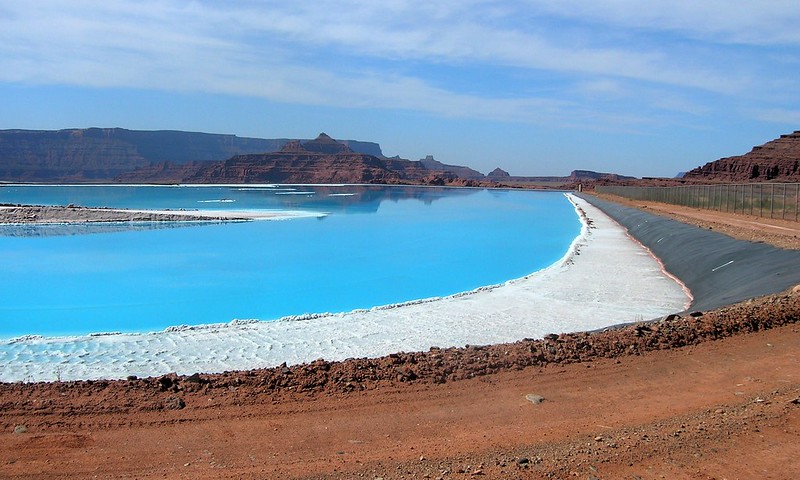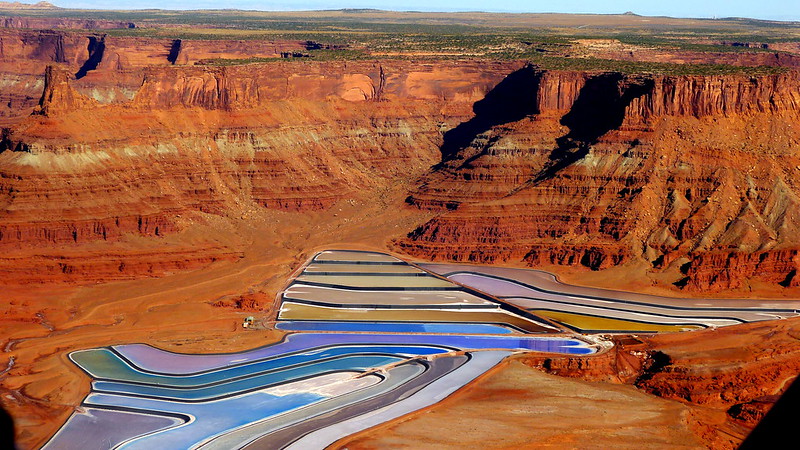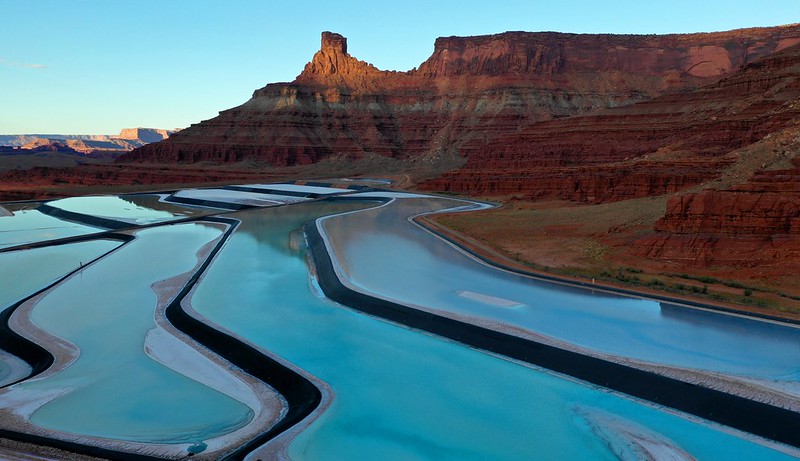Potash Ponds — These electric blue molds in the brown desert are potash fumes from ponds operated by Intrepid Potash, Inc., the largest producer of potassium chloride in the United States. These ponds are located along the course of the Colorado River, about 30 kilometers west of Moab (Utah, USA). These ponds have an area of 1.5 square kilometers and are lined with rubber to retain the salt.
 |
| Potash evaporation ponds |
Potash Ponds
Potash pond — Unlike other saltwater evaporation ponds, which get a natural reddish hue due to the presence of some algae, the rich, bright blue color of these evaporator potash ponds Moab is due to an artificially added colorant that aids in the absorption of sunlight and accelerates the evaporation process. After the water evaporates and only potassium and other salts remain, they will be collected and sent for recycling.
Utah Ponds — Most of the world's potassium reserves on earth are from ancient oceans that once covered the land. After the water evaporates, potassium salts crystallize in large potash deposits. Over time, due to natural erosion of the earth's surface, precipitation and cataclysms, potash deposits turn out to be underground and become potash ores. The basin of deposits in Moab pools is estimated to contain 2 billion tonnes of potash fertilizers. They formed about 300 million years ago, and today they are at a depth of about 1200 meters below the surface.
Potash Utah — In the Moab, United States mine, to extract potash from the ground, miners drill wells in the mine and pump hot water to dissolve the potassium that is about 1,200 meters below the surface. The resulting brine is pumped out of the wells to the surface and fed into the evaporation ponds.
Potash Mine
Potash Mine — To extract ore from the ground, workers drill wells, lower a pump into the potash mine, and pump hot water inside to dissolve potassium. The resulting solution is pumped out of the wells to the surface and poured into evaporation tanks. The sun evaporates water, leaving crystals of potassium and other salts. This evaporation process usually takes about 300 days.
Intrepid Potash, Inc. produces 700-1000 tons of potash fertilizers per day from this potash mine Utah. The mine has been open since 1965, and Intrepid expects to continue extracting potash from it for at least 125 years before the potash ore dries up.
Potash Pond
As you know, in addition to being used in fertilizers, potassium nitrate is widely used in the manufacture of pyrotechnic products. For example, potassium chlorate is used in mixtures of colored fire.
First Image / Source
 |
| Potash ponds Utah |
Image / Source
Potash Mine Pools
 |
| Potash ponds |
Image / Source
 |
| Potash mine |
Image / Source
 |
Potash Road Moab |
Image / Source
 |
| Moab UnitedSstates |
Image / Source
 |
| Potash evaporation ponds |
Image / Source
 |
| Potash Moab |
Image / Source
 |
| Potash Utah |
Image / Source
 |
| Potash mine pools |
Image / Source
 |
| Evaporation pond |
Image / Source
 |
| Potash mine Utah |
Image / Source
 |
| Ponds USA |
Image / Source
 |
| Potash ponds Moab |
Image / Source
 |
| Moab pools |
Image / Source
The pool of potash, an amazing natural pool in the midst of Utah desert, Quite frequently this pool changes its color at Moab, Utah US. It is not a Pool but an Artificial Potassium Mind which attracts visitors to the pond.

No comments:
Post a Comment